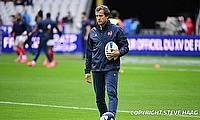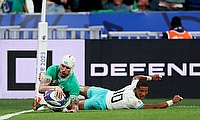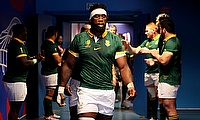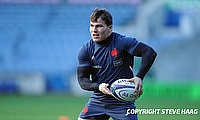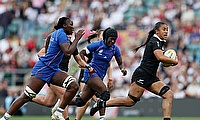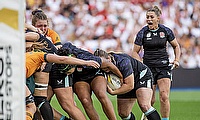What next for French rugby?
Throughout its history, France has had its fair share of mad kings and revolutions. And with the end of Marc Lievremont's tenure at the head of the French national team following last year's World Cup, a rugby revolution was expected in France as the hugely successful Phillipe Saint-André replaced 'Mad Marc'.
It may seems strange that a side that made it to the World Cup final and came within a drop goal of winning would be in need of an overhaul, but after some pretty abject performances along the way to the final and the shambolic off-field relationship between players and coach, change was always going to be necessary.
But the revolution has not yet come to pass. The vastly experienced Saint-André's first campaign in charge of the French national side heralded Les Blues' worst Six Nations performance since 2001, and despite possessing the sort of individual talent that only Wales can hold a candle to, the 2010 champions failed produce the results and performances expected of them.
As with England, this year's Six Nations marked the beginning of a transitional period for the France team, but whereas Stuart Lancaster started afresh, only two players were handed debuts by Saint-André, with a handful of the many players used and discarded by Lievremont returning alongside the old guard.
While it is common for squads to ring the changes and blood new players the first tournament following a World Cup to begin the progression towards the next, it is perhaps even more surprising given the new managing staff and the number of prominent players retiring or nearing the end of their careers that Phillipe Saint-André chose such a conservative squad.
France's 30-man Six Nations squad contained no less than 14 players over the age of 30. Compare that to the seven members of the 30+ brigade in Wales' Grand Slam winning side, and a mere five in the England camp and it becomes apparent that the current France squad will be in need of some overhaul come the next World Cup. Stalwarts William Servat, Lionel Nallet and Julien Bonnaire have all played their last games for their country, and will be up to the likes of Dimitri Szarzewski and the impressive youngster Yoann Maestri to step up and fill their rather imposing boots.
Despite the poor campaign, there were a number of positives to take away from the Six Nations for Saint-André; the performances of Maestri and particularly fellow debutant Wesley Fofana were nothing short of sensational, and look set to don the blue of France for many a year to come. However as has been the case for some time now, the real problem lies in the half-backs, and as it has done for several years the number 10 shirt in particular.
Just as Italy are perceived as being a quality fly-half away from becoming a competitive side, France need somebody to step up and make the 10 jersey their own to give them direction, and to turn them into the world class team they should be.
It is unlikely Phillipe Saint-André will be any clearer who the fly-half to take his France side forwards is follow the Six Nations. His first five games in charge saw the on-off flair and excitability of Francois Trinh-Duc put up against the conservative Lionel Beauxis and his monstrous boot. And if the selection of Beauxis against England was tactical then its lack of success should have been enough to keep him out of the starting line-up against Wales, but still he remained, to little effect. David Skrella has been in fine form for Clermont Auvergne this season, but he has already proved to struggle at international level, and looking at the current batch of French fly-halves in the Top 14, there is nobody else standing out.
Phillipe Saint-André has said that he will not be looking to experiment in the same way as Marc Lievremont with the intention of creating an air of stability, but he will have to if he is to make the necessary changes. The decision to stick with players who aren't likely to make the next World Cup was clearly a short-term attempt at success, a failed attempt that has meant a missed opportunity to start building towards the future.
There is no doubt that the fans in France will have been disappointed by their side's performance following their poor showing in the Six Nations, but levels of dissent from Les Bleus' fan base have been lower than what may be expected in the British Isles. The real attraction when it comes to French rugby is at club level, where the passion and intensity of the players on the pitch and the fans in the grandstands come to life. National pride and the success of the national team may be important, but success at club level and getting one over on your closest rivals is where it is at in France. While France may be currently underachieving at an international level, the Top 14 can boast a wealth of stars from across the rugby world in a competition so fiercely fought, that even the likes of 2009 champions Perpignan and a Biarritz side fielding the likes of Dimitri Yachvili, Imanol Harinordoquy and Nicolas Mas are both fighting to avoid relegation.
With the exception of Toulouse “ Europe's most successful club lest we forget “ France's club sides have enjoyed great success in Europe this season. Clermont Auvergne can go a long way to proving their worth as they take on Leinster in the Heineken Cup semi-final, while in the less important (but no less challenging) Amlin Challenge Cup, it is a French monopoly with all four semi-final spots taken by French clubs, including the struggling Biarritz and Brive.
There is little doubt that the much higher salary cap in place in France is a contributing factor to the current success of French sides, as well as the mass exodus of (largely Welsh) players to the Top 14. It wasn't long ago that there was no real salary cap in place in France, although since the 2009-10 season, a cap of just over £7 million per year has been in place (in contrast, the Aviva Premiership's is a maximum of £4.2m). It says a lot about the financial pull of the French clubs when Lyon “ a side destined for the second tier D2 next season “ have pulled in the likes of Wales international Huw Bennett, and French legend Sebastian Chabal.
There is always the danger that with the high levels of money rolling around and the number and quality of foreign players it brings in that the national side can be affected as home-grown players can be overlooked in favour of big named internationals. No more so is this the case than in France's quest for a world-class 10. Perhaps as a result of the lack of quality fly-halves, over half of the teams in the Top 14 have regular fly-halves who have come from outside of France. Even the likes of Lionel Beauxis and David Skrella are not guaranteed a starting place, with Luke McAlister and Brock James respectively often keeping them out of the starting XV, and potentially hindering their progress as players.
It isn't a problem across the board “ there is home-grown quality abound in the Top 14, and in the case of the top two, Toulouse and Clermont, over half of France's Six Nations squad are regular starters for each side. There are a host of youngsters too vying to follow Wesley Fofana's step up into the international scene, and it is up to Phillipe Saint-André to find the new French stars, without embracing the farcical circus show that was Marc Lievremont's selection policy.
Domestically, French rugby is going from strength to strength, and it is in Phillipe Saint-André's hands whether the international side will follow. There is a glorious pool of talent at his disposal, and it is critical that he keeps both players and fans onside and creates an air of stability around French rugby. Stuart Lancaster has shown how simple it can be, and the sort of effect it can have on a squad individually lacking compared to their Gallic counterparts, but the French have a particular talent for creating a storm in a teacup regardless of who is their king. One thing is for sure, we know that whatever direction they head, France will always manage to excite.

